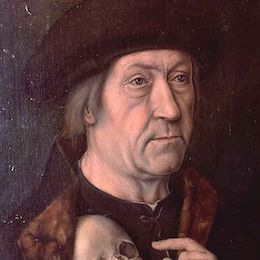Michel Sittow
1469 (Tallinn, Estonie) / 1529 (Tallinn, Estonie)
Eldest son of the Flemish cabinetmaker and painter Claes van der Sittow and his Finnish wife Margaret Mölnare, Michel Sittow was born in 1469 – in an illegal beer factory – in Reval (now Tallinn in Estonia), a Finnish city -Ugric then populated by more than 6,000 inhabitants. And it was in this flourishing port, affiliated with The Hansa and bought from the Danes by the Germanic order of the Teutonic Knights in the 12th century, that he died in 1525, after a life of vagrancy. Trained with his father and then in the industrious workshop of Memling in Bruges, at the end of the 1480s, the young Sittow married the honest, simple and realistic grace of the German-Flemish master to the colorful and luminous style of Jean Hey, the Master of Mills. From 1492, we find Sittow in the Spain of the Reconquista where he worked, under the name of Melchior Alemán, Mychel Flamenco or Michiel, often in concert with Jean de Flandres, for Isabella the Catholic – who, at 23 years, pays him royally. After his departure from Spain on the death of the queen in 1504, Michel settled in Flanders, at the court of Philip the Handsome, before perhaps leaving briefly for England. He ended up giving his leave to the new King of Castile to return home to Reval/Tallinn in 1506 to settle his mother's estate.
Eldest son of the Flemish cabinetmaker and painter Claes van der Sittow and his Finnish wife Margaret Mölnare, Michel Sittow was born in 1469 – in an illegal beer factory – in Reval (now Tallinn in Estonia), a Finnish city -Ugric then populated by more than 6,000 inhabitants. And it was in this flourishing port, affiliated with The Hansa and bought from the Danes by the Germanic order of the Teutonic Knights in the 12th century, that he died in 1525, after a life of vagrancy. Trained with his father and then in the industrious workshop of Memling in Bruges, at the end of the 1480s, the young Sittow married the honest, simple and realistic grace of the German-Flemish master to the colorful and luminous style of Jean Hey, the Master of Mills. From 1492, we find Sittow in the Spain of the Reconquista where he worked, under the name of Melchior Alemán, Mychel Flamenco or Michiel, often in concert with Jean de Flandres, for Isabella the Catholic – who, at 23 years, pays him royally. After his departure from Spain on the death of the queen in 1504, Michel settled in Flanders, at the court of Philip the Handsome, before perhaps leaving briefly for England. He ended up giving his leave to the new King of Castile to return home to Reval/Tallinn in 1506 to settle his mother's estate.
